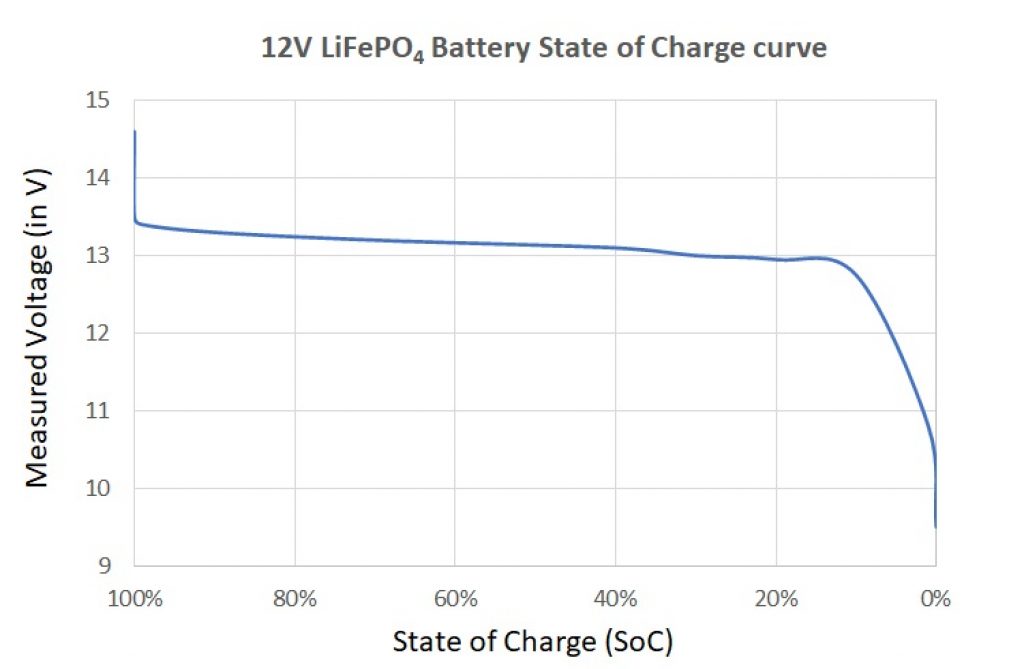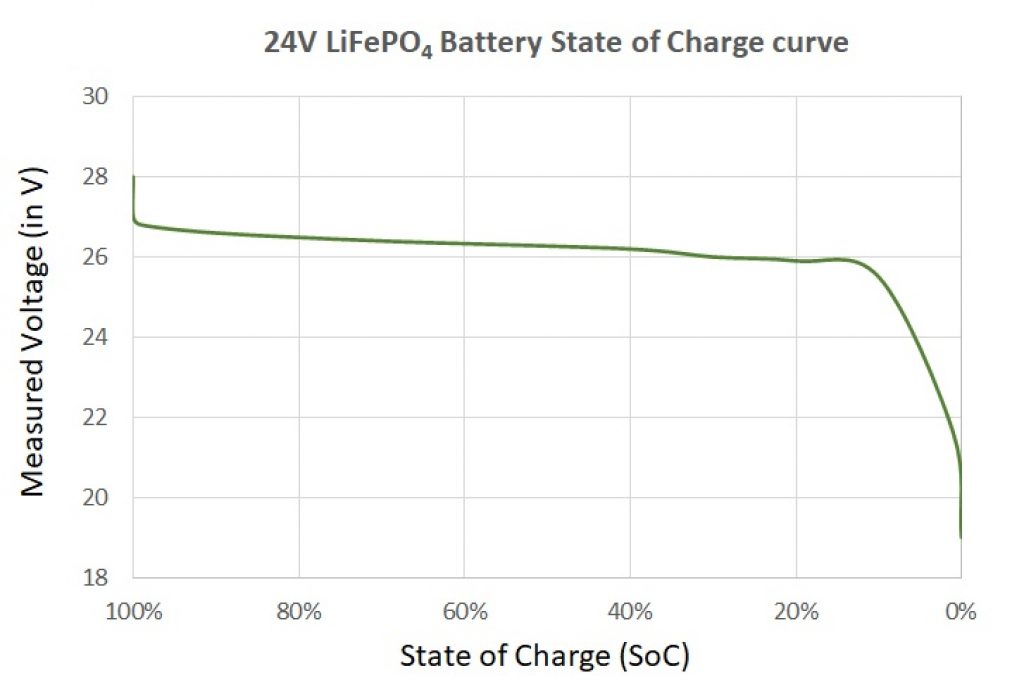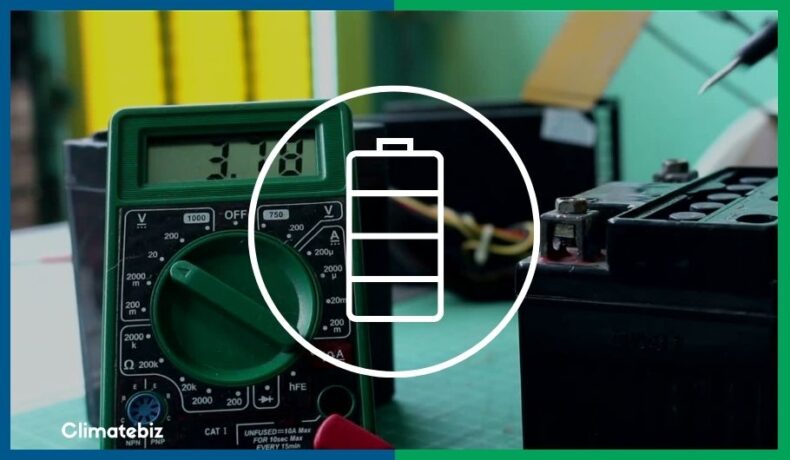Are you looking for LiFePO4 state of charge charts? You’ve come to the right place!
LiFePO4 batteries are currently the most efficient energy storage technology. They provide significant advantages such as high energy density and long durability.
As opposed to their Lead-acid counterparts, LiFePO4 batteries can be more deeply discharged (80% to 90% maximum recommended Depth of Discharge, instead of the 50% for lead-acid batteries).
This is possible because the LiFePO4 battery’s voltage is well maintained during discharge. It only starts dropping considerably at around 20% state of charge.
In fact, you can estimate a LiFePO4 battery’s state of charge by measuring the battery’s resting voltage. How? By using our LiFePO4 State Of Charge Charts.
In this article, we’ll discuss LiFePO4 state of charge in detail. In addition, we’ll provide you with LiFePO4 State of Charge charts, so you can estimate how much battery capacity you still have at any moment.
Table of Contents
What Is A LiFePO4 State Of Charge
A LiFePO4 State of Charge (or SoC) expresses the present capacity of the battery relative to its total capacity. This definition applies to other battery chemistries.
State of Charge is given in percentage. 100% SoC means the battery is fully charged, while 0% means fully discharged.
You can calculate it using:
State of charge (%) = Remaining Capacity (Ah) / Total Capacity (Ah)
Knowing the state of charge of your LiFePO4 battery is helpful because it tells you how many Amp-hours you can still draw from your battery.
For example, if you measured your 12V 200Ah LiFePO4 battery’s voltage and concluded — using the LiFePO4 state of charge charts provided in this article — that its present state of charge is 70%, then you know you can still use roughly 140Ah from your battery.
For this, you can use:
Remaining capacity (Ah) = State of Charge (%) x Total Capacity (Ah)
So in the example above, the Remaining Capacity (Ah) = 70% SoC x 200Ah = 140Ah
The inverse of State of Charge is the Depth of Discharge (or DoD). It refers to the percentage of capacity that has been discharged relative to the battery’s total capacity.
Therefore, if your battery’s DoD is 40%, its state of charge is 60%.
How is LiFePO4 State Of Charge Determined?
To understand how the state of charge is determined, let’s first review a few concepts:
Different Terms For Voltage
- Nominal voltage is the voltage provided by a fully charged battery under specified conditions of temperature and load. It depends on the battery’s chemistry.
- Rated Voltage is the voltage in which the battery operates reliably. Manufacturers usually round the nominal voltage of batteries to provide their rated voltages.
- The actual measured voltage of a battery decreases as it discharges.
- Open circuit voltage is the voltage measured between the battery terminals with no load applied. It is proportional to the battery’s state of charge.
LiFePO4 Battery Voltage
- A LiFePO4 battery is an assembly of several LiFePO4 cells. The number of cells in a battery will determine its nominal voltage.
- The nominal voltage of a LiFePO4 cell is 3.2V
- A 12V LiFePO4 battery is achieved by connecting four LiFePO4 cells in series.
- Similarly, a 24V LiFePO4 battery is achieved by connecting eight LiFePO4 cells in series or two 12V LiFePO4 batteries in series.
- Finally, a 48V LiFePO4 battery is achieved by connecting sixteen LiFePO4 cells in series or four 12V LiFePO4 batteries in series.
| Rated Voltage | Nominal Voltage |
|---|---|
| 3V | 3.2V |
| 12V | 12.8V |
| 24V | 25.6V |
| 48V | 51.2V |
Now that we’ve got this out of the way, let’s look at how you can estimate the state of charge by measuring the open-circuit voltage:
Determining SoC Using The Voltage Method
This method enables you to estimate the remaining capacity of your LiFePO4 battery by measuring the battery’s voltage.
For this, you need to use a voltmeter (or multimeter) to measure the battery’s open-circuit voltage (when there’s no current) and use the appropriate LiFePO4 state of charge chart to check the capacity that corresponds to the voltage reading.
For example, if you measured a 13.2V voltage for your 12V LiFePO4 battery, you can check the 12V LiFePO4 state of charge chart to establish that your battery’s state of charge is 70%.
Although this method is pretty simple and easy to perform, it’s important to point out that the battery’s current/discharge rate and temperature significantly affect the voltage.
In addition, the design goal of a battery is to provide a voltage as constant as possible — despite the change in the state of charge — which makes this method difficult to apply.
Determining SoC Using The Current Integration Method
Battery Management Systems use this method to determine the battery’s state of charge. This is important because the role of the BMS is to control your battery’s charging process by regulating its voltage input and output, preventing any damages to your battery.
Therefore, the BMS must continuously monitor voltage, amperage, and state of charge.
To calculate the SoC, the BMS measures the battery’s current and integrates it with respect to time.
The battery’s internal monitoring system does this integration. To measure the SoC yourself (using a voltmeter and LiFePO4 state of charge charts), stick to the Voltage Method.
12V LiFePO4 Battery Voltage Chart
Here we present the LiFePO4 state of charge chart for 12V LiFePO4 batteries:
| State of Charge | Voltage |
|---|---|
| 100% (charging voltage) | 14.4V |
| 100% (open circuit) | 13.5V |
| 99% | 13.4V |
| 90% | 13.3V |
| 70% | 13.2V |
| 40% | 13.1V |
| 30% | 13.0V |
| 20% | 12.9V |
| 10% | 12.8V |
| 1% | 10.8V |
| 0% | 9.5V |
table for a 12V LiFePO4 battery
And its corresponding curve:

Source: Climatebiz
As previously mentioned, you can roughly estimate the state of charge (the battery’s remaining capacity) by its rest voltage (when not charging or discharging, zero current).
12V LiFePO4 batteries are a popular option for solar battery systems, especially for small-scale projects.
Important note: Voltage values can slightly differ for each LiFePO4 battery, so be advised that the values presented in the following tables are for reference only. Moreover, checking your LiFePO4 battery’s user manual can provide more accurate information for your specific LiFePO4 battery.
24V LiFePO4 Battery Voltage Chart
Here we present the LiFePO4 state of charge chart for 24V LiFePO4 battery systems:
| State of Charge | Voltage |
|---|---|
| 100% (charging voltage) | 28.8V |
| 100% (resting voltage) | 27.0V |
| 99% | 26.8V |
| 90% | 26.6V |
| 70% | 26.4V |
| 40% | 26.2V |
| 30% | 26.0V |
| 20% | 25.8V |
| 10% | 24.6V |
| 1% | 21.6V |
| 0% | 19V |
table for a 24V LiFePO4 battery
And its corresponding curve:

Source: Climatebiz
A 24V LiFePO4 can be obtained by connecting two 12V LiFePO4 is series.
48V LiFePO4 Battery Voltage Chart
Here we present the last one of our LiFePO4 state of charge charts for 48V LiFePO4 battery systems
| State of Charge | Voltage |
|---|---|
| 100% (charging voltage) | 57.6V |
| 100% (resting voltage) | 54.0V |
| 99% | 53.6V |
| 90% | 53.2V |
| 70% | 52.8V |
| 40% | 52.4V |
| 30% | 52.0V |
| 20% | 51.6V |
| 10% | 49.2V |
| 1% | 43.2V |
| 0% | 38V |
table for a 48V LiFePO4 battery
And its corresponding curve:

Source: Climatebiz
48V LiFePO4 batteries aren’t common, especially for small-scale solar battery systems.
Also, be very cautious and use insulating gloves when handling 48V battery systems. As a rough rule of thumb, 50V is sufficient to drive a potentially lethal current through the human body.
What Is The Absorption Time For A LiFePO4 Battery?
Compared to Lead-Acid Batteries, LiFePO4 batteries have a more straightforward charging process.
| Battery Chemistry | Charging Phases | Average Charging Time |
|---|---|---|
| Lead-Acid batteries | Bulk, Absorption, and Float | 10 hours |
| LiFePO4 batteries | Constant Current (CC) and Constant Voltage (CV) | 4 hours |
“Absorption” is a concept borrowed from the charging profile of Lead-Acid batteries. It refers to the charging phase in which the battery maintains a constant voltage while the current gradually decreases.
Once the current reaches a certain low point (depends on the C-rate), the charging process is completed, and the battery is fully charged.
Check your LiFePO4 battery’s User Manual to find the recommended charging current and charging voltage to optimize the charging process and minimize stress on your battery.
While the absorption time may vary from one brand to another, the average recommended absorption time for LiFePO4 batteries at a charging voltage between 14.2V and 14.6V is around 15 minutes.
For example, Battery Born Batteries recommends an absorption time of approximately 20 minutes per battery. Meanwhile, Canbat recommends 6 minutes of absorption time.
However, the absorption time of LiFePO4 batteries should not exceed 30 minutes to prevent overcharging.
Is LiFePO4 A Solid State Battery?
Not exactly.
The currently available and broadly used LiFePO4 batteries are not solid-state batteries since their electrolyte isn’t solid; it is liquid.
However, there are solid-state batteries currently being developed that use LiFePO4 battery materials (like the cathode), although many challenges are yet to be overcome, as LiFePO4 materials are known for having the issue of poor solid-state diffusivity.
Here’s a bit of information on solid-state batteries and LiFePO4 batteries that might help you understand the difference between them:
Solid State Battery
A solid-state battery is a new battery technology that uses a solid electrolyte, instead of the liquid or gel electrolyte found in traditional lithium batteries, such as Lithium Iron Phosphate (LiFePO4).
This battery technology is still in the stages of development. Still, it might become commercially available soon, as it offers many advantages over the current technologies, such as safety and higher durability.
Lithium Iron Phosphate Cells
LiFePO4 cells are made of the following components:
- Cathode: LiFePO4
- Anode: Graphite
- Electrolyte: Lithium Salts in an organic solvent
- Separator: Polyethylene microporous membrane
Therefore, unlike Solid-State batteries, LiFePO4 batteries don’t contain a solid electrolyte; the electrolyte is liquid.
To summarize, the currently available LiFePO4 batteries are not solid-state batteries, but there could be a Lithium Iron Phosphate solid-state battery in the future if researchers figure out a way to make them efficiently.
By How Much Can LiFePO4 Batteries Be Discharged?
Unlike Lead-acid batteries (which recommended DoD is 50%), LiFePO4 batteries can be continually discharged to 100% DoD without suffering any major performance issues. However, doing so can drastically reduce your LiFePO4 battery’s life cycle.
Therefore, if you want to get the most out of your LiFePO4 battery, you should check the user manual for the recommended maximum Depth of Discharge (DoD).
Usually, manufacturers recommend a DoD of 80% for LiFePO4 batteries. After that, you should recharge your battery.
This practice maximizes your LiFePO4 battery’s life cycle and overall performance.
Final Thoughts
Despite the high upfront cost, a LiFePO4 battery offers many advantages for solar energy storage systems, such as higher DoD, long durability, higher energy density, and lightweight.
But to enjoy all the perks your LiFePO4 offers, it’s vital that you understand how your battery works and the relationship between some basic battery specifications, like life cycle, nominal voltage, depth of discharge, and state of charge.
Once you’re familiar with these concepts, you can use the LiFePO4 State Of Charge Charts presented in this article to determine your battery’s state of charge. This can come in handy when you need to estimate how much capacity your battery can still provide.

